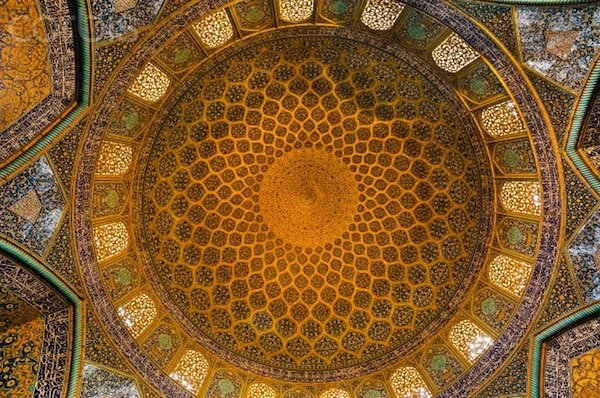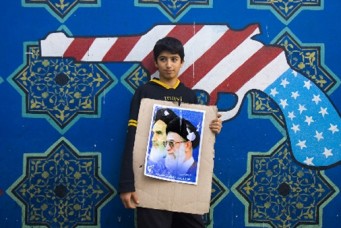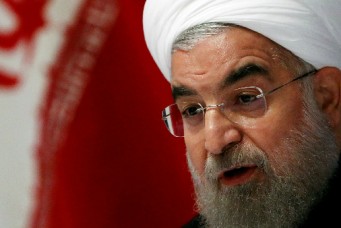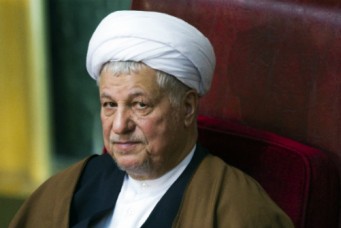Beauty of the Pleiades
Arabs have the greatest respect for the faith and culture of Iranians, as well as the indelible Persian contribution to the marvels of Islamic society. But like all worthwhile achievements, Persia’s greatest masterpieces were the product of cooperation and education, of learning from and with people of other backgrounds.

There is a tradition that states that the Prophet Mohammed (PBUH) once gestured toward his Persian companion Salman and said:
لو كان الإيمان عند الثريا لناله رجال من اهل فارس
“Even if faith were near the Pleiades, men from among the Persians would attain it.”
This tradition points to a few fundamental truths about Persian history and identity. In the ancient world, the Pleiades constellation represented the universe’s beauty and mystery, and its distance in the sky was a reminder of the vastness of creation. In invoking the Pleiades, the Prophet (PBUH) was testifying to the power of the Persian’s faith—that there was no obstacle large or far enough to prevent the Persians from attainment of true knowledge.
We can also read this tradition as a testament to the Persian tradition of scientific and cultural achievement—that if anyone were able to grasp at the Pleiades, it would of course be the Persians. In the Prophet Mohammed’s time, Persia was a fading imperial power, holding on to the glories of its civilization as it prepared to embrace a new era. Even today, Iran is caught between pride in its ancient and complicated history and the ambitions of its religious regime.
In the pre-Islamic world, the Persian Sasanian Empire, founded in 224 ad and extending from Turkey and Egypt to the Indian subcontinent, was a cultural and political force rivaling that of ancient China, India, Greece, or Rome. The Sasanians were envied by the Romans for their advanced military technology, Sasanian artists and musicians were welcomed by the royal courts of imperial capitals, and the Sasanian government was widely praised for its humane and effective style of rule. The Persians of the ancient world could even lay claim to one of the world’s monotheistic religions: Zoroastrianism, a faith based on the teachings of Zoroaster, who lived over 3,000 years ago.
By the seventh century ad the golden age of the Sasanians had long since passed away. When Muslim Arabs arrived shortly after the death of the Prophet (PBUH), Persians came to accept Islam and adjust to life under Arab rule. The Persian language adopted its own version of the Arabic script and borrowed heavily from Arabic vocabulary. Ancient fire temples were converted into arched mosques with beautiful, serene courtyards. The Persians of greater Iran adopted the political ideals represented by the Islamic caliphate and became participants in another Golden Age, one with far more geographic breadth and cultural diversity than the Persian kingdoms of ancient times.
During the medieval flowering of Islamic civilization, Persian people and Persian culture helped raise the Islamic World to greater heights of scientific and artistic power. As Europe struggled in its Dark Ages, Persia produced some of the Islamic World’s most famous scientists, mathematicians, theologians, and poets. Al-Ghazali, the theologian, scholar, and mystic often referred to as one of the most important Muslims after the Prophet Mohammed (PBUH), was from a city near Mashhad in present-day Iran. The legendary polymath Avicenna (or Ibn Sina), the greatest scientist and medical scholar of his age and author of over four hundred texts and a master of the Greco-Roman and Indian scholarly traditions, made time to compose poetry in his native Persian. Hafez Shirazi is still one of the world’s most famous and influential poets, and Persian poetry left an indelible stamp on South Asian literature and art. Omar Khayyam is well known not only for his quatrains but also for his astronomical and mathematical genius. Al-Khawarismi gave us algebra and introduced the zero into mathematics.
In the later Middle Ages, newer Islamic dynasties like the Mughals, the Timurids, and the Ottomans took their cue from Iranian art and literature to cultivate their own civilizations. The flowing Nastaliq script of written Persian, known for its beautiful long and sloping letters, was adopted by the Urdu language and revered by Ottoman artists, who used it as an inspiration for their own styles of calligraphy. Persian architecture set a new standard for physical beauty in houses of worship in the Islamic world.
But even in the Islamic Golden Age, Persians held some nostalgia for the purity and power of their culture and history. The poet Ferdowsi’s Shahnameh, or Book of Kings, an epic of Persian legends and history from the dawn of time until Islam, was written around the year 1000 ad, and Ferdowsi was careful to avoid Arabic influence on his vocabulary—he wanted a Persian epic to be represented in undiluted Persian prose.
With the rise of the Safavid dynasty in the sixteenth century, Persia experienced another great shift. The Safavids installed Twelver Shia Islam in their kingdom, and Persia became a majority Shiite country as well as a locus of Shiite religious scholarship. The ancient city of Qom was Safavid Persia’s crowning intellectual jewel, a site of religious pilgrimage, which became the largest center for Shiite Islamic scholarship in the world. Under Safavid rule, Persia grew in religious prestige as its reputation as a center of aesthetic innovation declined.
By the 1800s, Persian artistic and intellectual elites no longer delighted in the poetry of the Shahnameh or studied the mysticism of Al-Ghazali but instead sent their sons to French finishing schools or took long vacations to European museums and salons. Iran’s 1905 Constitutional Revolution laid bare the corruption of the crumbling Qajar dynasty: in the early twentieth century, Persia was vulnerable to Soviet expansion and colonial European influence, caught between larger powers. Shah Mohammad Reza Pahlavi, who came to power in the aftermath of a 1921 coup, was able to rescue Iranian pride of place from a geopolitical morass. His modernization programs—Western-style university education, better healthcare, the development of railways and infrastructure—helped the nation to join the developed nations of its era as a peer. The shah was aware of his peoples’ need to feel pride in a uniquely Persian heritage, and he capitalized on that need to bolster support for his regime. It was Reza Pahlavi who insisted that foreign nations refer to Persia by its ancient name of Iran. In doing so, the shah was intentionally evoking thousands of years of Aryan lineage and framing the modern Iranian state around its ancient ethnic identity. The shah’s son went by the honorific Aryamehr, or “light of the Aryans”; while the name might sound antique, it was an innovation meant to remind Iranians of their roots, to restore the dignity of the concept of a specifically Iranian, rather than Islamic, government.
The shah’s regime represented a step forward for Iran in many ways, but at the same time, Pahlavi’s secular and authoritarian rule alienated the country’s more religious current. In 1971, the Pahlavi government spent vast amounts of time and money to celebrate the 2,500th anniversary of the Persian Empire founded by Cyrus the Great. It was a lavish affair, with food catered from Paris and giant tents equipped with the latest technology. The event was broadcast on international television. As the shah paraded his wealth and lineage in front of the world, some Iranians grew angry: the religious right called the celebration “The Devil’s Festival,” Shiite clergy and the religious faithful were marginalized by the shah’s secular regime, while many leftists in Iran protested the methods of the shah’s secret police and what they saw as the increasingly repressive tone of political discourse. The Islamic Revolution of 1979, which installed the powerful yet polarizing Khomeini as supreme leader, was a new and different articulation of Iranian identity.
Khomeini’s claim to rule was based on his interpretation of the concept of “the guardianship of the jurists,” a Shiite doctrine articulated in the late nineteenth century which gave varying degrees of civil authority to religious scholars trained in Shiite Islamic law. Khomeini drastically expanded popular understanding of the doctrine, enforcing his own interpretation of “guardianship,” and giving himself, as the country’s premier religious leader, unchecked authority over Iran’s political affairs.
When the Islamic Revolution of Iran replaced the shah’s elegant but fallen regime, some Iranians rejoiced at the prospect of Iran’s resurgence as an Islamic power. Others dreaded a move that they felt would divorce Iran from the rest of the world. Iran’s Islamic Revolution was a worldwide media sensation: in 1979, Ruhollah Khomeini became not only the leader of a nation but TIME magazine’s “Man of the Year” and the singular face of Islamic rule worldwide. While Khomeini’s “guardianship” did not extend politically beyond Iran’s borders, his words and actions sent a message of an ambitious and wide-reaching claim to Islamic leadership; a new caliphate, but with Shiite practice.
Khomeini combined the Persian imperial ambition of the shah with the more recent Shiite authority of his intellectual ancestors in Qom. This was an Iranian empire like no one had ever seen: insular, combative, and eschewing cultural exchange in favor of a claim to universal truth. It took on a pugilist’s stance, not an embracing one. Many Muslims around the world were dismayed by Khomeini’s sudden claim to speak for them and what seemed like callous disregard for other Islamic traditions and ways of life. Muslims who followed theological traditions very different from the Twelvers’ and lived in countries with rulers who were nothing like Khomeini were disturbed to have their religion so closely linked with Khomeini’s image, and to witness Khomeini embrace the role as the supreme leader not just of Iranians but of the entire Islamic world.
In 1980, and after miscalculating the extent of the political struggle that followed Khomeini’s return to Tehran, Saddam Hussein launched his abortive attempt to topple Khomeini. For two years and until Saddam’s troops were pushed back into Iraq, none of the Arab Gulf states supported him. Unfortunately, Khomeini vowed revenge and launched a counterattack on Iraq. He also miscalculated and the Iraqi people, Sunni and Shiite alike, united in opposing Khomeini’s aggression. Only then did the Arab Gulf states come to the aid of Iraq.
Khomeini’s intention may have been to unite Muslims under a single banner, but, like Saddam, the aftermath of his actions thirty years later have only served to further divide the Muslim world.
Today, the lofty beauty of the Pleiades can seem very far indeed from the reality of daily life in Iran. The country is marked not by worldliness or even by religion but by isolation; in contrast to the traveling artists of the Sasanians and the multilingual scholars of the Islamic Golden Age, many famous and well-respected Iranian artists today have trouble even getting on a plane to another country. Khomeini’s imperial ambitions have restored Iran’s Islamic identity, but they have also doomed the country to a cramped and narrow existence. Interaction between Iran and its Muslim neighbors is limited and often hostile. In the aftermath of Khomeini’s death, Iran’s leaders have chosen to expand its nuclear program, a move that further damaged Iran’s relationships with the international community. The sanctions arising from Iranian leaders’ decisions have severely strained the country’s economic and political opportunities and forced its citizens to close themselves off from much of the outside world. And yet clerical authorities in Iran still tend to act as if they lead the Islamic World; issuing ultimatums, intimidating their neighbors, and inciting dissidence and revolution.
Iran has the right to use nuclear power for peaceful purposes, but brinksmanship policies and the construction of secret facilities do nothing to serve the country’s best interests; nor do these policies allay the world’s suspicions. The best way to move forward fairly on this issue is for Iran’s leaders to follow the policy set down by the shah in 1974. The establishment of a Weapons of Mass Destruction free zone in the Middle East will ensure a level playing ground for all nations in the region. Iran’s leaders claim to support the zone. That support should not be by lip service only.
Iranians can be proud of their history and heritage. Arabs have the greatest respect for the faith and culture of Iranians, as well as the indelible Persian contribution to the marvels of Islamic society. But like all worthwhile achievements, Persia’s greatest masterpieces were the product of cooperation and education, of learning from and with people of other backgrounds. Just as Arabs, Africans, Europeans, and Asians continue to be enriched by Persian knowledge and culture, Iran has been greatly enriched by its Arab, Asian, and European partners. Pushing away these interlocutors, dividing Muslims with bombastic claims to religious leadership, threatening their neighbors with false claims to Bahrain, and refusing all rational solutions to the dispute over the Emirati islands, will not restore the former glory of Iran; it will do just the opposite. Supreme Leader Ayatollah Ali Khamanei’s meddling in Iraq is the cause of the daily killings and suffering that the Iraqi people are enduring. The situation in Syria, in which the Iranian government has chosen to support the butcher Al-Assad, is a case in point. Ruhollah Khomeini was famous for his claim as the champion of the mustazafin. Today, Khomeini’s successors have chosen to support the oppressor, not the oppressed.
Khomeini wore the black turban that signified his pride in his long and noble Arab lineage. Khamenei, Khatami, and even Nasrallah wear it also. But the Iranian leadership’s meddling in Arab countries is backfiring. Arabs will not be forced to wear a political suit tailored in Washington, London, or Paris. They also reject even the fanciest garb cut by the most skillful tailor in Tehran.
The Iranian leadership has the opportunity to share so much of Iran’s heritage and wisdom with other Muslims. But if they wish to gain the respect of other countries, they must first show respect to the traditions, heritage, and political identity of their peers. The Islamic conversation is richer with the Iranian voice in it—but theirs cannot be the only voice we hear.
A version of this article originally appeared on October 22, 2013.
Prince Turki Al-Faisal, a former Saudi ambassador to the United States and to the United Kingdom, is chairman of the King Faisal Center for Research and Islamic Studies. This essay is adapted from Prince Turki Al-Faisal’s remarks to the National Iranian American Council in Washington, DC, on October 16, 2013.





